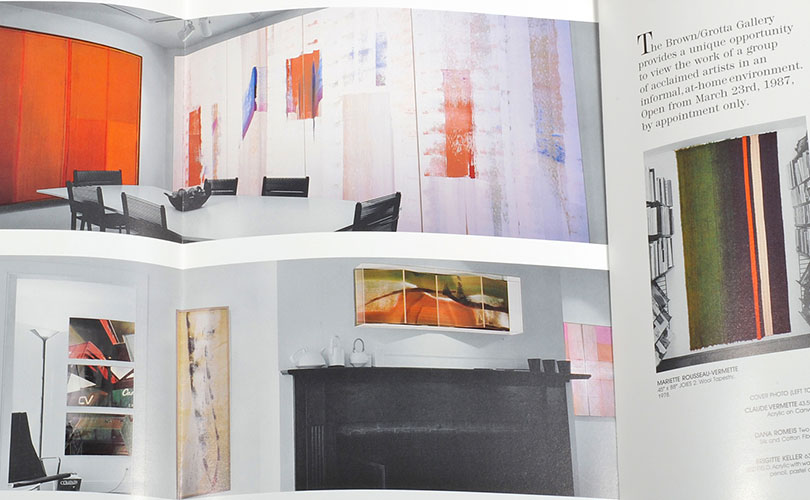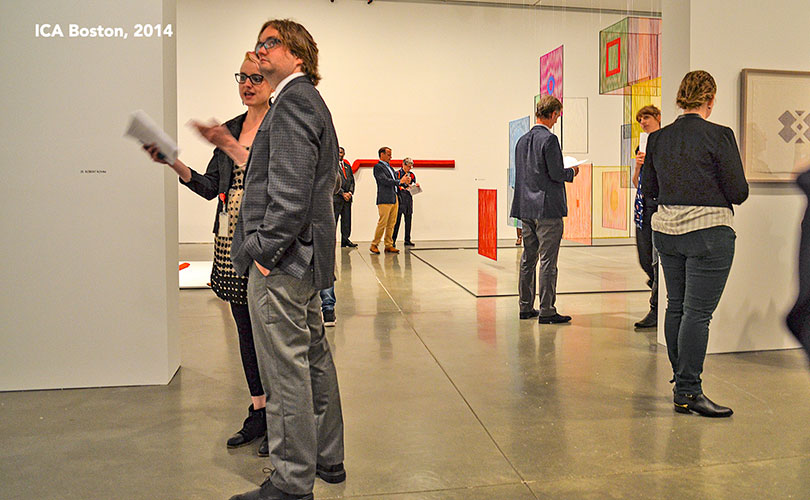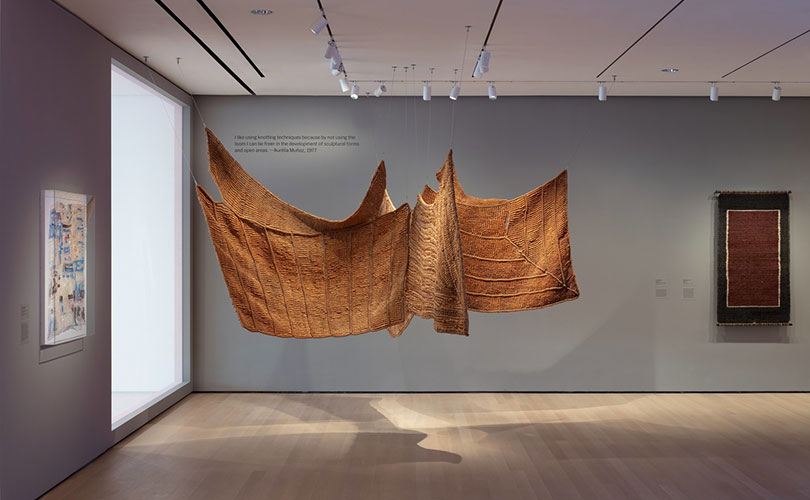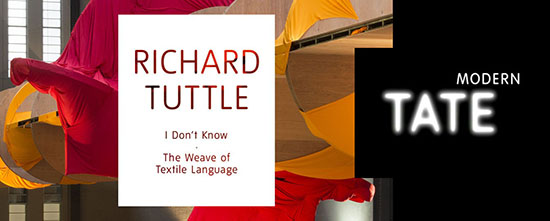In December of 2021 of last year, we were asked to talk to a group of fiber artists about trends we had observed in the art textiles field. In two arttextstyle posts we’ll summarize the insights we shared with the group. First, we described a bit about browngrotta arts’ creative journey and fiber arts’ place in the art world in the years we’ve been the medium’s champion.

browngrotta arts began quite informally in 1987, showing artwork in our Connecticut home at parties or by appointment – a concept we called “art in use.” We quickly discovered two things – First, people weren’t terribly willing to buy paintings from a suburban home, with New York galleries nearby. Second, fiber work was not well represented on the East Coast. The fiber art we showed, however – baskets by Mary Merkel-Hess and Markku Kosonen, and tapestries by Mariette Rousseau-Vermette – was new and interesting to clients and us. We decided to focus on that.

Fiber art on the outs
That said, 90s and early 2000s were not great for fiber art. The slick and shiny were popular in furnishings and design. Some of the public fiber commissions from the 70s had begun to show their age and give fiber a bad name. The craft/art divide was harsh and dark – and women’s work, like weaving, knitting and crochet – was at the bottom of that chasm. The period saw fiber friendly galleries like Sybaris in Detroit, Louise Allrich in Califoria, and Bobby Okun in Santa Fe all close their doors. But we hung in there, with our unusual business model – presenting fiber artists from Japan, Scandinavia, the UK and pioneering and emerging artists from the US, attending art fairs, partnering with art centers and documenting the work in catalogs and on our website.

In 2006, we curated Beyond Weaving: International Art Textiles at the Flinn Gallery in Greenwich, Connecticut, which included work by Sheila Hicks, Magdalena Abakanowicz and Lenore Tawney. Mildred Constantine, the former textile curator at MoMA, told us it was the “best fiber exhibition in 15 years,” which tells you a lot about how the medium had been sidelined in that period.
Gradual reemergence
But slowly, in that time period, fiber’s profile began to improve. Appreciation for natural materials increased as did appreciation for the hand made. Sheila Hicks had an exhibition of miniatures at Bard in 2006; Ruth Asawa a retrospective at the de Young 2007; 50 years of Sheila Hicks opened at the Addison, then the Mint and ICA in Boston in 2010 and so did Contemporary Fiber Art: a selection from the Permanent Collection at the Art Institute in Chicago.

The watershed for fiber art’s resurgence was just four years away. In 2014, Janelle Porter, who had worked on 50 Years of Sheila Hicks, organized the expansive ICA show, Fiber Sculpture – 1960 to the present. The exhibition travelled to Columbus, OH, Produced a detailed book and Porter was awarded a best museum exhibition award.
It was as if a dam had broken – 50 Fiber artists toured the US in Innovators and Legends in 2013, initiated at the Muskegon Museum of Art, a retrospective of François Grossen’s work opened at Blum and Poe and one of Ethel Stein’s work opened at the Art Institute of Chicago in 2014. Anne Wilson, Louise Bourgeois, Lenore Tawney were also featured in Thread Lines at the Drawing Center 2014. Richard Tuttle unveiled a vast installation of weavings in Tate Modern (followed by an exhibition of Textiles by Sonya DeLauney in 2015). The Art Newspaper declared: “Soft Fabrics Have Solid Appeal;” the Wall Street Journal called Fiber “The Art World’s New Material Obsession.”

Fiber Art’s Continued Recognition and Appreciation
The trend has continued since – Anni Albers at the Tate in 2018; Women Take the Floor in Boston; Off the Wall: American Art to Wear in Philadelphia and Taking Thread for Walk at MoMA, all in 2019,Weaving Beyond the Bauhaus in Chicago in 2020 and Olga d’Amaral’s Weaving a Rock in Houston in 2021 and at Cranbrook in 2022. Sheila Hicks, Off the Grid, at The Hepworth Wakefield in West Yorkshire, UK, Faith Ringgold, American People at the New Musuem in New York City open this year as do 34 fiber artists, including Lia Cook, in Subversive, Skilled, Sublime: Fiber Art by Women at the Smithsonian in November.
It’s an exciting time to promote art textiles and fiber sculpture as browngrotta arts has done for three decades. In Contemporary Fiber Art — Trends Observed, Part 2, we’ll examine some of the changes we’ve seen in the field and in the approach of the artists who work with us.

The Resurgence of Interest in Fiber Sculpture and Art Textiles Will Continue in 2015
Last year was an extraordinary one for those of us who appreciate contemporary art fiber and art textiles. More than 10 exhibitions opened in the US and abroad. In October, the art newspaper reported that “textiles are gaining international stature in art museums” and further that “[c]ommercial interest is on the rise,” quoting art advisor Emily Tsingou: “Textile [art] has entered the mainstream.” Soft Fabrics-Have Solid Appeal. Below is a roundup of exhibitions and reviews from last year and a guide to what to expect in 2015.
Mainstream attention began with the coverage of Sheila Hicks‘ inclusion
Sheila Hicks, Pillar of Inquiry/Supple Column, 2013-14 (installation view, Whitney Museum of American Art, New York). Photograph by Bill Orcutt
in the Whitney Biennial in March and was followed by coverage of the restoration of her remarkable 1960s tapestries at the Ford Foundation in New York Sheila Hicks Tapestries to Again Hang at Ford Foundation. In June, the Art Institute of Chicago’s textile galleries reopened, featuring 96-year-old Ethel Stein’s work, in Ethel Stein, Master Weaver.
September saw three fiber-related exhibitions; the Museum of Arts and Design opened What Would Mrs. Webb Do? A Founder’s Vision (closes
February 8, 2015),Kay Sekimachi, Ed Rossbach, Françoise Grossen, Katherine Westphal and others Museum of Art Design installation of What Would Mrs Webb Do?, Photo by Tom grotta
February 8, 2015), which featured significant textiles from the permanent collection by Anni Albers, Kay Sekimachi, Katherine Westphal, Ed Rossbach, Françoise Grossen and Trude Guermonprez, while The Drawing Center’s: Thread-Lines offered Anne Wilson creating fiber art in situ
Ann Wilson’s In Situ Performance at the Drawing Center, photo by Tom Grotta
together with a collection of works by Lenore Tawney, Louise Bourgeois and others. Contemporary 108 in Tulsa, Oklahoma, featured a series of large photographic weavings by Aleksandra Stoyanov of the Ukraine
Contemporary 108 in Tulsa, Oklahoma, curated from the 2013 “Aleksandra Stoyanov” Tefen Open Museum, Israel exhibition. photo copyright Tefen Open Museum
and now Israel, described as “warp and weft paintings.”
In October, Fiber: Sculpture 1960 – present, opened at the Institute of Contemporary Art in Boston with works by 34 artists including
Fiber: Sculpture 1960 — present opening, photo by Tom Grotta
Magdalena Abakanowicz, Ritzi Jacobi and Naomi Kobayashi. The Boston Globe called the exhibition “[s]plendid, viscerally engaging…groundbreaking;” the exhibition catalog (available at browngrotta.com) was pronounced by Blouin art info, “an amazing resource for anyone interested in learning more about the medium.” Art Info – Art in the Air Fiber Sculpture 1960 Present October also saw a survey of the work of sculptor and poet, Richard Tuttle, at the Tate in London, Richard Tuttle:
I Don’t Know, Or The Weave of Textile Language in which Tuttle investigated the importance of textiles throughout history, across his remarkable body of work and into the latest developments in his practice. Tate Modern – Richard Tuttle I Don’t Know or Weave Textile Language
Throughout the year, Innovators and Legends, with work by 50 fiber

artists, including Adela Akers, Nick Cave, Katherine Westphal and Sherri Smith toured the US, exhibiting at museums in Colorado, Iowa and Kentucky. The fiber fanfest culminated at Art Basel in Miami Beach in December, where Blouin’s Art Info identified a full complement of fiber works and textiles in its listing, “Definitive Top 11 Booths, “ including Alexandra da Cunha’s compositions of mass-produced beach towels and various colored fabrics at Thomas Dane Gallery, a Rosemarie Trockel embroidered work at Galerie 1900-2000, marble and dyed-fabric pieces by Sam Moyer at Galerie Rodolphe Janssen and woven paintings by Brent Wadden at Mitchell-Innes & Nash Blouin Art info – The Definitive Top-11 Booths at Art Basel Miami Beach.
And what’s ahead in 2015?
More auctions and exhibitions that include fiber sculpture and art textiles are scheduled for 2015. Fiber: Sculpture 1960 – present will
open at the Wexner Center for the Arts, Columbus, Ohio on February 7th and travel to the Des Moines Art Center, Iowa in May.
Sonia Delaunay Prismes electriques 1914 Centre Pompidou Collection, Mnam / Cci, Paris © Pracusa 2013057
dedicated her life to experimenting with color and abstraction, bringing her ideas off the canvas and into the world through tapestry, textiles, mosaic and fashion.
Also in April, the Museum of Arts and Design will host Pathmakers:
Lenore Tawney in her Coenties Slip studio, New York, 1958.
Courtesy of Lenore G. Tawney Foundation; Photo by David Attie
Women in Art, Craft and Design, Midcentury and Today, featuring work by Sheila Hicks, Lenore Tawney and Dorothy Liebes http://madmuseum.org/exhibition/pathmakers.
In June, the Toms Pauli Foundation in Lausanne, Switzerland will celebrate the International Tapestry Biennials held there from 1962 to 1995 and display work by the Polish textile artist and sculptor Magdalena Abakanowicz, in an exhibition entitled, Objective Station.
1995 and display work by the Polish textile artist and sculptor Magdalena Abakanowicz, in an exhibition entitled, Objective Station.
Also this summer, the Musée d’Art Contemporain de Baie St Paul in
Mariette Rousseau Vermette Portrait by Tom Grotta
Quebec, Canada will examine the work of Mariette Rousseau-Vermette, who participated in five of the Lausanne Biennials.
From April 24 – May 3, 2015, browngrotta arts will host Influence and Evolution, Fiber Sculpture then and now at our barn/home/gallery space in Wilton, Connecticut. In its 27-year history, browngrotta arts
Françoise Grossen, From the Mermaid Series IV, 1983, photo by Tom Grotta
including Magdalena Abakanowicz, Lia Cook, Kay Sekimachi and Françoise Grossen, with works from a later generation of artists, all born after 1960, through whom fiber sculpture continues to evolve. These artists, including María Eugenia Dávila and Eduardo Portillo of Venezuela, Stéphanie Jacques of Belgium and Naoko Serino of Japan, work in a time when classification of medium and material presents less of a constraint and fiber and fiber techniques can be more readily explored for their expressive potential alone.
“It is rare to find so many inventive, compelling works in one show, and it astounds that many are so little known,” wrote Kirsten Swenson in Art in America, about Fiber: Sculpture 1960 – present, in October 2014. Art in America Magazine – reviews: Fiber Sculpture 1960-present. This spring, in Influence and Evolution, browngrotta arts will offer dozens more significant works of fiber art for collectors to appreciate and new audiences to discover — more than two dozen works by fiber pioneers and another 30 more recent fiber explorations. We hope you will visit the exhibition, order the catalog or both. Please contact us for more information about what’s in store. art@browngrotta.com